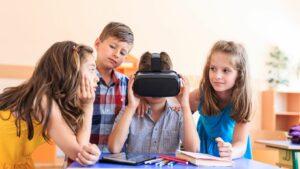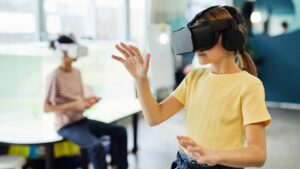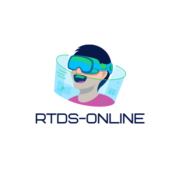Immersing into the world of Virtual Reality (VR) isn’t just about gaming anymore. It’s transforming how we learn and acquire new skills. From classrooms to boardrooms, VR learning experiences are revolutionizing the educational landscape, offering an immersive, interactive approach to learning that’s both engaging and effective.
VR Learning Experiences
From Concept to Classroom
 Early attempts at VR for education were limited by prohibitive costs and clunky technology. Equipment was complex and required technical know-how, pushing it out of reach for most educational institutions. However, advancements in technology and reductions in price transformed VR from a costly endeavor to an educational tool with limitless possibilities.
Early attempts at VR for education were limited by prohibitive costs and clunky technology. Equipment was complex and required technical know-how, pushing it out of reach for most educational institutions. However, advancements in technology and reductions in price transformed VR from a costly endeavor to an educational tool with limitless possibilities.
Incorporation of VR in education migrated rampantly into classrooms across the world. Schools began investing in affordable VR devices like Google Cardboard, bringing immersive experiences to students regardless of budget. As a result, classrooms evolved into engaging learning spaces where students could explore history, revisit ancient civilizations, or dive deep into the human body – all at the click of a button!
Benefits of VR in Education
Following the exploration of VR’s growth and evolution in education comes the discussion of the benefits. It becomes evident that the adoption of VR in academic settings yields numerous advantages, particularly in boosting student engagement and providing safe platforms for complex simulations.
Enhanced Engagement and Retention
 One major benefit of VR in education is increased student engagement, which, in turn, boosts content retention. Plain text and 2D images often challenge the attention span of learners, leading to reduced engagement and poor retention rates. VR provides immersive, 3D learning experiences, capturing students’ attention remarkably. For example, exploring the Amazon rainforest virtually, as opposed to studying it from a textbook, intensifies the learning experience. Studies substantiate this, indicating significant improvement in test scores and information recall when educational content is presented through VR.
One major benefit of VR in education is increased student engagement, which, in turn, boosts content retention. Plain text and 2D images often challenge the attention span of learners, leading to reduced engagement and poor retention rates. VR provides immersive, 3D learning experiences, capturing students’ attention remarkably. For example, exploring the Amazon rainforest virtually, as opposed to studying it from a textbook, intensifies the learning experience. Studies substantiate this, indicating significant improvement in test scores and information recall when educational content is presented through VR.
Safe Simulation of Complex Scenarios
Another compelling advantage of VR in education lies in its ability to create safe environments for students to navigate complex scenarios. This attribute is vital, particularly in fields like medicine, engineering, and aviation. VR-based training can mimic real-life situations – an example can be seen in surgical training, where VR allows medical students to practice intricate procedures in a risk-free environment. Similarly, engineering students can test bridge designs or flight students can practice landing techniques, all without the potential dangers inherent in real-world practice. With safety being paramount, VR’s role in providing controlled simulation settings aids significantly in learning.
Challenges in Implementing VR Learning Experiences
While VR enhances education, it also presents unique challenges. Let’s delve into technical limitations, costs, and educational content development.
Technical Limitations and Costs
Despite strides in VR technology, some hurdles persist. High-performance VR systems entail significant financial commitment. Oculus Rift, for example, costs around $400 excluding the required high-end PC. For large-scale implementation in educational institutions, investing in hardware can be a major financial barrier.
 Along with financial considerations, technical limitations also pose challenges. A high-powered computer is necessary to run complex VR applications. Connectivity issues can hamper VR experiences, while consistent software updates and troubleshooting can add to the maintenance costs. More importantly, using VR over extended periods can cause physical side effects like motion sickness, deepening the complexity of its implementation in educational settings.
Along with financial considerations, technical limitations also pose challenges. A high-powered computer is necessary to run complex VR applications. Connectivity issues can hamper VR experiences, while consistent software updates and troubleshooting can add to the maintenance costs. More importantly, using VR over extended periods can cause physical side effects like motion sickness, deepening the complexity of its implementation in educational settings.
Educational Content Development
On the content side, the creation of VR learning experiences requires considerable time and expertise. Compared to traditional eLearning content, VR experiences necessitate the conversion of flat images to detailed 3D models. The development process involves multiple disciplines like scripting, programming, and 3D modeling, often necessitating collaborations with VR specialists.
Moreover, the limited availability of VR-ready educational content can slow down adoption. A lot of VR content available primarily focuses on entertainment, not education. While some educational VR applications exist, diversifying and expanding this repertoire is vital for VR to reach its full potential in education.
In closing, while VR holds immense potential for educational advancement, overcoming these technical and content development challenges is crucial for successful implementation in learning environments. As technology evolves, so will the ways we tackle these challenges.

